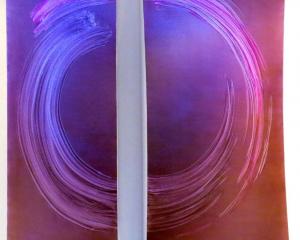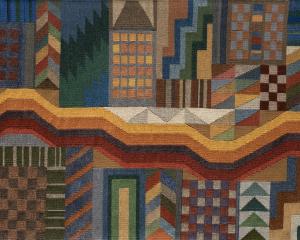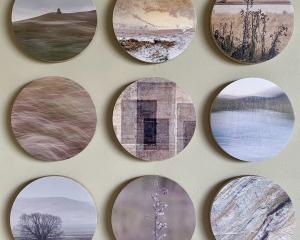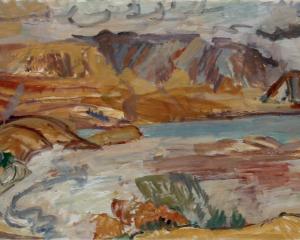Phyllis Smith, Kathy Palenski, Bronwyn Mohring, "Fine Feathers", Renaissance Gallery
The works of Phyllis Smith, Kathy Palenski and Bronwyn Mohring come together in an exhibition of ceramic art at Renaissance Gallery.
Mohring continues to work with owls.
Here, clay owls have been saggar fired in wood shavings and nut shells.
Mohring has then incorporated found and reinvented objects such as copper wire, branches and leaves.
In two works, both entitled Music Album, square holes have been cut into the books and the owl has been placed inside.
One album is open to a Chopin nocturne.
Palenski has produced a series of vases, plates and bowls, all of a natural, light-brown hue and glazed.
On to the glaze she has printed old dress patterns and pictures of women and children.
The traditional forms of the dishes are combined with the more contemporary prints of "fashion of the era".
Smith's contributions have come from research into her tupuna wahine; she has tracked her ancestors' history up and down the coast as they gathered kai moana and mahinga kai.
Koru Bowl and one Tiheru Bailerbowl echo waka forms.
Their rims are coloured and patterned in such a way as to resemble wood and carving.
The insides are blue and shine like water.
Smith has attached paua shells, referencing the gathering of food from the sea.
This exhibition may not have wide appeal, but is an interesting representation of three established artists' work in this medium.
Wayne Barrar's striking photographic exhibition, "An Expanding Subterra", is on at the Dunedin Public Art Gallery.
The work is divided into sections, including "Cinema Scope", "Deep Space" and "Frontier Land".
This division, as well as the international locations of the sites, emphasises the different uses of land and space, as well as the particular cultures and politics attached to land use.
Barrar's focus is on the underground.
These constructed subterranea have been allocated as areas for humans to work and play within, or as storage deposits for materials such as film stock and nuclear waste.
Air vent/crib room (deep mine), Mt Isa, Australia 2005 shows an area for respite and communication between mine workers.
The setting is in focus and the men in orange overalls are blurred: the permanence of the mine is met with the movement and change of the workers.
The clock hovers above, enforcing the sense of a long-term dwelling.
Two underground paintball fields in Kansas City are beautifully photographed.
The splatters of multicoloured paint against white and grey doors, windows and cave walls provides a telling image of the relationship between nature and culture.
Barrar has also included the work which sparked this seven-year-long project: the black-and-white photographs documenting the lives of residents in Coober Pedy, Australia.
These photographs are mesmerising images of the contemporary cultural landscape of building and burrowing.
Eighteen artists from around the country and working in a range of media have joined forces to celebrate the macrocarpa tree in an exhibition entitled "Macrocarpa", at Bellamys Gallery.
Sarah McKay has made coloured wooden blocks inscribed with images of native birds and connotative words relating to the macrocarpa such as "dark" and "gnarly".
Max and Simone Oettli have each done three inkjet prints, each image a different depiction of macrocarpa along Portobello Rd, Ridge Rd and in Broad Bay.
John Bellamy has created three woodcut prints, all inspired by the patterns made by marking macrocarpa wood with tools.
Local botanist Peter Johnson's work, A Macrocarpa Childhood, is shown in the same space as Lew's Last Log.
The latter is a film of Lew milling his last log of macrocarpa.
Johnson's piece consists of photographs set into finished pieces of macrocarpa, and explains the history of the tree in New Zealand.
Manu Berry and Pauline Bellamy have both taken new approaches to their individual printmaking processes.
Berry presents work in drypoint etching as well as screen-printed T-shirts; Bellamy explores the textures of combining silk-screening with drypoint.
Although the work is very different, this sophisticated exhibition flows extremely well as the macrocarpa theme, and the presence of the tree's mass, are felt throughout.












![Untitled (c. mid 1990s, [pink 3]), by Martin Thompson, 415mm×590mm. Photo: courtesy of Brett...](https://www.odt.co.nz/sites/default/files/styles/odt_landscape_small_related_stories/public/story/2024/02/untitled_pink_3.jpg?itok=Q0aQrc9o)